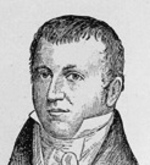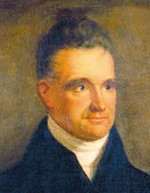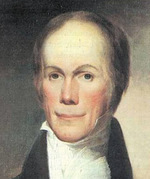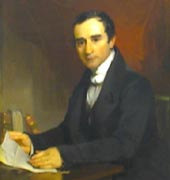National Republican Convention, 1832 |
 |  |  |  |
| Temporary Chairman
| Permanent Chairman | Presidential Nominee | Vice Presidential Nominee |
Former U.S. Senator
Abner Lacock PA | Former Secy of War
James Barbour VA | President
Henry Clay KY | Former U.S. Rep.
John Sergeant PA |
National Republican Party in the first Jackson Administration
Although the National Republican Party lost the White House in 1828, it remained strong in Congress. In the Senate, Democrats had a 25-23 margin; in the House, the Democrats had a more comfortable 132-72 margin. This was the Congress in which the famous Hayne-Webster debate took place on the issue of the sale of western lands. A major bone of contention between Congress and President Jackson was the issue of internal improvements; Jackson vetoed all bills which provided federal funding for projects located entirely inside a single state.
The midterm elections of 1830-1831 were not favorable to the Democrats; the Senate became evenly divided, while the House had 117 Democrats to 65 members from the NRP, 16 Anti-Masons, and 10 others.
Call of the NRP National Convention
In the late 1820s and early 1830s, gatherings of people with similar interests were becoming common. These "conventions" provided a break from the everyday work of the people of the era, who had far fewer means of entertainment than 20th century America. Both the National Republicans and the Democrats began to hold state conventions at which they would choose candidates for Governor and U.S. House.
The first step in calling the first national nominating convention came on 12/23/1830, when the National Intelligencer wrote that a convention had been called by the "friends of Internal Improvements, Domestic Industry, and Commercial Reciprocity" to nominate a candidate for President. Each state was invited to send delegates. The NI noted that Clay's supporters did not see the necessity at that time of holding such a gathering.
The NRP national convention was officially called by members of the Maryland legislature. Frustrated by Jackson's vetoes of internal improvement bills passed by Congress, the anti-Jackson members of the Maryland legislature met on 2/17/1831 in the Hall of the House of Delegates and called for a "National Convention ... to which the people of all the States shall be invited to send Delegates" to nominate a ticket to run against Jackson. The convention would be held in Baltimore on 12/12/1831. [Printed in the Annapolis Republican, 2/19/1831]
At first, there was little response towards the idea. However, as the spring of 1831 wore on, National Republicans started to warm to the idea. The Republican Star of Easton MD printed a small piece on 5/3/1831 in which it reminded the NRP state parties to send delegates to the Baltimore convention. This piece set in motion a series of state and local conventions across the nation in which delegates were chosen for the Baltimore convention.
The NRP National Convention
The convention was held on 12/12-15/1831 in the Athenaeum in Baltimore. At the opening session, there were 130 delegates from 17 states and the District of Columbia. Thirty-eight additional delegates arrived before the close of the convention. Six states were not represented, four of which were in the deep South.
Temporary Chairman: Abner Lacock PA
Permanent Chairman: James Barbour VA
On the fourth day of the convention, the roll call ballot for President took place. The convention heard a letter from Henry Clay, in which he stated that the delegates should feel free to choose him or someone else if they felt it was warranted; he would support their decision.
The chairman of the convention called the name of each delegate, who gave his vote orally. Clay received 155 votes, with delegate Frederick H. Shuman of North Carolina abstaining because he believed that Clay could not win and should wait until 1836. This was the only convention of a major party in which the chairman called upon all delegates individually for their votes.
As additional delegates arrived, they were allowed to cast their votes for Clay, and by the end of the convention he had 167 votes to one abstention. A similar procedure was used for the vice presidential ballot; John Sergeant of Pennsylvania was nominated with 162 votes to six abstaining.
After the vice presidential ballot, the convention attended to some minor business matters. It appointed a committee to work with Baltimore delegates to defray convention costs. It also appointed a committee to visit Charles Carroll of Carrolton, the last surviving signer of the Declaration of Independence, then adopted an address to the citizens of the nation before adjourning sine die.
Popular Vote of 1832
Electoral Vote of 1832
[Less...]

